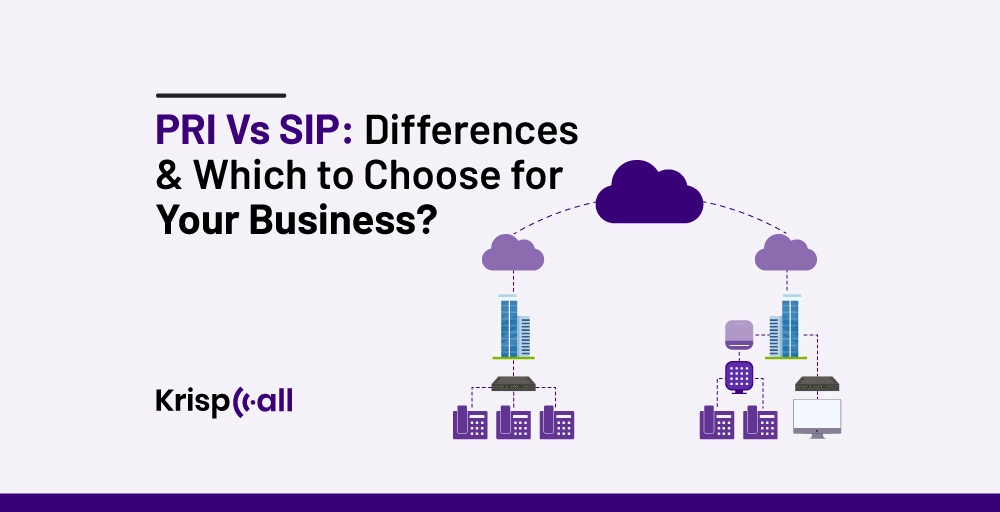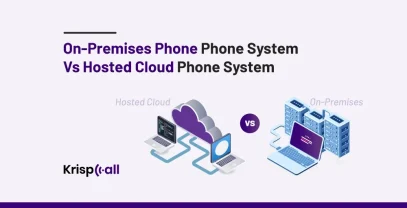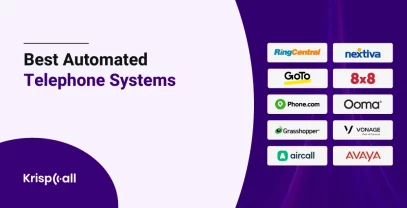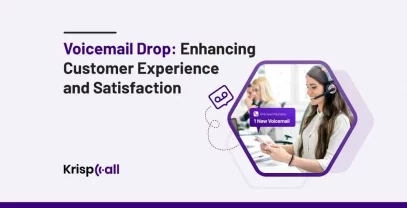In the modern world of competitive businesses, They rely on various advanced communication tools to keep the conversation flowing with customers and business partners daily. But, One thing that is niggling to them is staying adaptable.
The Primary Rate Interface (PRI) requires a physical connection, while the modern, sleek SIP needs a signaling protocol. Both technologies serve similar purposes when connecting to the 📞 telephone network, but they vary in adaption.
Why are some businesses still adapting PRI while others are moving ahead with SIP nowadays? Keep scrolling to learn the differences between those two lines and decide which is the right line for your business. 💼
🔑 Key Highlights
- The Primary Rate Interface(PRI) is a part of the telecommunication line that links the business telephone systems to the public switched telephone networks (PSTN).
- Session Initiation Protocol (SIP) connects your Internet Protocol (IP) PBX to the Internet, allowing you to make and receive calls through the Internet or robust bandwidth.
- While migrating from PRI to SIP, first of all, you need to Evaluate and plan, select a SIP service provider, and choose post-migration support
- The significant difference between them is that PRI uses traditional ISDN signaling and physical lines, while SIP operates over an IP network and offers virtual connections.
What is PRI?
PRI (Primary Rate Interface) is an integral part of the telecommunication line that links business telephone systems to public switched telephone networks (PSTN). A PRI line consists of 23 B channels for voice or data, one signaling channel for call control, and information such as caller ID.
PRI transmits data between two physical locations and carries multiple voices over copper wire. It implements the (ISDN) Integrated Services Digital Network protocol to provide a digital connection instead of analog landlines. It transmits voice calls as electrical signals and routes calls via traditional telecommunication companies.
It is famous among businesses such as call centers, offices, hotels, and hospitals. They use it for their business phone system support for a high volume of concurrent calls and reliable voice and data services.
Moreover, they gain tremendous benefits, such as increased call capacity, fast data transmission, integrated voice or data, and cost-effectiveness using PRI.
Features of PRI
In the following section, you will find some of PRI’s critical features to understand how it works better.
Simultaneous Communication: PRI lets 23 communications with its 23 B-channels functionality for voice and data. Therefore, it allows 23 calls at once over a single T1 line. PRI helps to enhance the capacity of call volumes and business efficiency.
Flexible Configuration: PRI lines provide a high level of configuration flexibility. Businesses can allocate channels for voice or data transmission depending on demand. This adaptability ensures companies can effectively tailor their PRI setup to align with their communication requirements.
Automatic Call Distribution: PRI allows ACD functionality through a PBX system. The PBX system handles multiple calls simultaneously by carrying numerous voice channels between it and the PSTN. By efficiently distributing incoming calls to available agents, ACD enhances call center efficiency and customer service.
Basic Requirements for PRI
The Basic Requirement for PRI is compatible equipment. The PRI-compatible equipment is a PRI gateway or a PBX with a PRI card that interfaces with digital lines. The other requirement for PRI is that it should work with analog or private automatic branch exchange systems.
Do you ever wonder, “Who is PRI Best For?” PRI is best for private foundations looking for impact-driven investments while effectively generating financial returns. When the number of calls increases, it is best to add additional PRI circuits to increase the calls’ capability.
💡 Read More: Integrated Service Digital Network: A Beginners Guide
What is SIP?
SIP, or Session Initiation Protocol, is a telecommunication technology that connects your Internet Protocol PBX to the Internet, allowing you to make and receive calls over the Internet or strong bandwidth.
SIP trunking can also facilitate scalable voice calls in businesses. It reduces multiple communication channels into a single virtual connection, effectively using resources while stabilizing the connection to a telephone network.
Furthermore, SIP is one protocol that enables VoIP (Voice over Internet Protocol) technology. You may have heard about email or web services. Like those, you can access voice through the IP network with SIP trunking.
It helps businesses move forward with IP phone communication, leaving traditional physical limitations behind. All in all, you can make your phone system digital and get the flexibility to add and replace lines.
Features of SIP
SIP offers a variety of valuable features. We have selected some of the most useful features to share with you:
Unified Communications
SIP seamlessly integrates voice, video, and other communication and collaboration capabilities. It gives users access to all the resources they need in one place, streamlining communication and increasing productivity.
Big Cost Saver
SIP-enabled VoIP phones are a cost-effective solution for businesses looking to save big chunks of money on local and international phone calls. SIP calls utilize the internet to make and receive calls, meaning that the only cost applied is the Wi-Fi bill.
Security
SIP supports various security methods, such as authentication, authorization, and encryption. These methods ensure that only authorized personnel can communicate and that conversation data is encrypted end-to-end. Thus, you can ensure that your communication remains confidential and authentic.
Scalable
SIP is designed to be scalable, handling many users and sessions without issues. Whether a business is small or large, SIP can handle the workload and quickly scale up or down as needed. With this level of scalability, companies that need to communicate with many people can do so without any problems.
Basic Requirements for SIP Trunking
When you switch to SIP trunking, you need to know the Basic Requirements. First, you need a strong internet connection and a PBX or IP PBX compatible with SIP.
Other basic requirements are a VoIP phone for desk phones, a VoIP adapter for traditional phones, and internet access between your VoIP phones and PBX server. However, you may need extra hardware and configuration for older PBX systems.
Who is SIP Best For? SIP is best for businesses that need cost-effective, flexible, and scalable communication solutions.
💡 Read More: SIP Calling: Everything You Need to Know
What is the difference between PRI and SIP trunking?
While PRI was considered the best option for fast synchronous communication several years ago, this is no longer true. However, more businesses are adopting SIP Trunking, a highly scalable and efficient virtual phone system.
Likewise, there are many differences between PRI and SIP trunking, which are:
| Feature | PRI | SIP Trunking |
| Technology | It uses Traditional phone networks (circuits). | It uses Internet Protocol (IP). |
| Number of Lines | It has a fixed (typically 23 channels) and needs to be more flexible. | It is scalable, where you can add or remove channels easily. |
| Cost | It requires higher upfront and ongoing costs | It requires lower overall costs, with potential per-line pricing |
| Scalability | It is difficult and expensive to scale. | It is easy and affordable to scale up or down. |
| Equipment needed | It requires a PRI gateway and ISDN-compatible equipment. | It requires an SIP-enabled PBX or gateway. |
| Maintenance | It may require more maintenance due to physical infrastructure. | It generally requires less maintenance, as it’s software-based. |
| Integration | Limited with newer phone systems. | It integrates seamlessly with VoIP systems and unified communications tools. |
| Security | It is generally considered a more secure (dedicated network). | Additional security measures may be required on your internet connection. |
Pros & Cons of PRI
Like every coin with two sides, PRI has pros and cons. Nevertheless, it depends on your needs. Let’s explore some of the pros and cons of PRI to clarify better.
| Pros of PRI | Cons of PRI |
| PRI is highly reliable as it uses lines to transmit calls that offer high call quality through POTS (Plain Old Telephone System) technology. | PRI requires high investment because of its dependency on physical infrastructure and hardware, setup, and high maintenance costs. |
| PRI is compatible with current legacy telephone systems. | PRI needs more scalability since it requires the physical connection of additional lines. |
| PRI allows businesses to have 50 DID numbers on one PRI circuit. | PRI takes longer to recover if you ever damage lines. |
| It is not dependent on IP data connectivity to support voice communications. | Moving PRI is challenging as you have to install it physically at your location. |
👉 Pros & Cons of SIP Trunking
Are you looking for an affordable voice communication solution? SIP trunking is the perfect choice. However, it also has some demerits and merits.
| Pros | Cons |
| Cost savings on high-volume and international calls | Dependent on the internet – call quality interrupts on internet outages |
| Seamlessly integrates with communication channels like voice, video, and text in a single platform | Security concerns like cyber threats and DoS attacks |
| Customizable options depending on your business needs | Bandwidth issues as SIP trunking relies on one network |
Things to Consider while migrating from PRI to SIP
Shifting from PRI to SIP involves several factors that need careful consideration. Here are things to consider while migrating from PRI to SIP:
Evaluate and plan
Before implementing SIP, you must ensure that your current infrastructure is compatible. This may require upgrading your software and hardware to ensure seamless integration. Additionally, you should evaluate the network bandwidth and quality of service (QoS) configuration to ensure they are adequate for your needs.
Furthermore, it is essential to note that SIP relies heavily on a dependable internet connection to provide quality calls, so it is recommended that you consider upgrading your connection if necessary.
Select a SIP service provider
Research and compare different SIP providers based on pricing, reliability, support, and compatibility with your existing system. Consider SIP providers that can help your business scale and adapt to your changing business needs.
In addition, make sure to match the provider’s features to your business needs, such as Call forwarding, Call and contact tagging, Voicemail to email, and so on.
Apply
Be well-prepared before migrating a new system to troubleshoot any emerging issues during the migration process. Then, coordinate with your current service provider and SIP provider to ensure the number porting process goes smoothly.
Additionally, check the new system to the maximum extent possible and train your staff to use the latest features and functionalities before fully deploying it.
Choose on post-migration support.
After migration, staying in touch with your SIP provider for any necessary changes or issues is essential. Establish a communication channel with your SIP provider to ensure continuous assistance and address any problems that may arise.
Additionally, create a strategy for regularly monitoring your SIP service to guarantee optimal performance.
💡 Read More: SIP Trunking: Everything You Need to Know
Create cloud communication adoption effortless with KrispCall
With all these discussions, there might be a better alternative than PRI and SIP.
Also, have you considered a cloud-based phone system as a possible option for your business?
Unlike PRIs and SIPs, a business phone system offers valuable tools to your team so that you can contact customers and assist them. Additionally, it lowers your infrastructure costs and increases productivity.
Nevertheless, businesses are increasingly adopting the cloud due to its flexibility and scalability to stay competitive. While you might be fond of your phone system’s traditional ring, it’s time to part ways and adapt to customer and partner needs.
With SIP trunking, you can amp up your phone system in several ways. In addition to being flexible and cost-effective, it is also adaptable.
So, if you’re looking for more than a SIP or PRI connection for your business phone system, or you’re looking for an all-in-one solution.
Take a look at how KrispCall can improve your team’s productivity. It could also lower your calling costs by up to 60%, which is a win-win situation for everyone.
Final Words
In the world of telecommunication, PRI and SIP are two essential components that connect companies to regional telephone networks, which connect them to the world. However, their connection methods completely differ as PRI creates a physical link to the PSTN, while SIP operates through a virtual connection. But the thing is, technically, both do the same thing.
And while PRI and SIP have various pros and cons of their own, SIP is the better one as it outperforms PRI in cost-effectiveness, flexibility, and scalability. That is why many businesses choose to migrate from PRI to SIP.
FAQs
Is PRI similar to VOIP?
PRI (Primary Rate Interface) is not the same as VoIP. PRI uses a communication technology different from SIP. PRI (Primary Rate Interface) uses physical circuits and copper wires, whereas VoIP uses the Internet to deliver voice and data.
How many lines do a PRI have?
PRI (Primary Rate Interface) has 23 that can support 23 phone calls simultaneously.
Which is Better: SIP Line VS PRI?
SIP is generally better for cost-effectiveness, flexibility, and scalability, whereas PRI provides security, reliability, and better connections with particular voice communication requirements.
What do you mean by SIP Line?
The SIP (Session Initiation Protocol) Line is the individual line from a SIP trunk. It implements the Internet to transmit voice calls.
Which is cheaper: PRI or SIP?
SIP is around 40% cheaper than PRI because of lower long-distance and international rates.
What do you mean by multi-line SIP?
Multi-line SIP is a single trunk more likely to SIP that can handle two or more voice calls at once.
What is the difference between PRI vs. SIP vs VOIP?
The difference between PRI vs SIP, vs VoIP is their connecting methods. To elaborate, PRI uses physical circuits and copper wires, SIP uses virtual connections through a network, and VoIP uses the Internet over IP networks for the connection.





